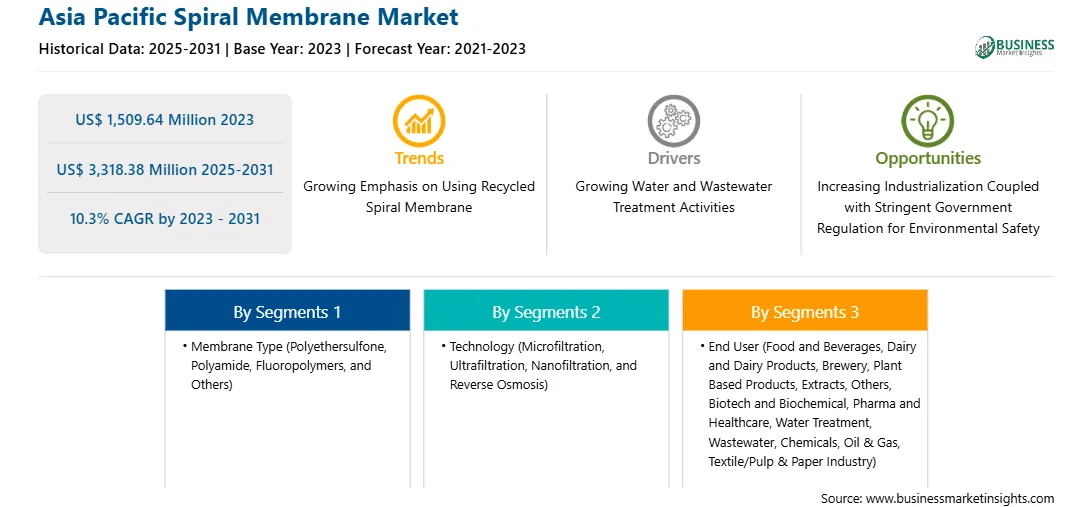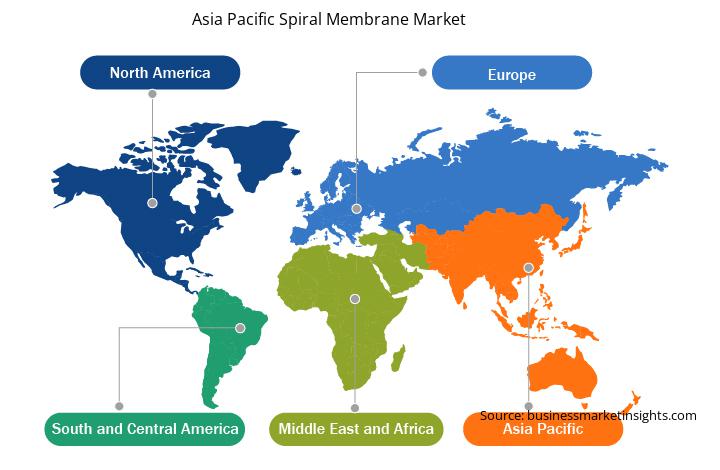The Asia Pacific spiral membrane market was valued at US$ 1,509.64 million in 2023 and is expected to reach US$ 3,318.38 million by 2031; it is estimated to register a CAGR of 10.3% from 2023 to 2031. Increasing Industrialization Coupled with Stringent Government Regulation for Environmental Safety Boosts Asia Pacific Spiral Membrane Market
Significant investment prospects and restructured business models in the post-pandemic scenario are the main factors contributing to rapid industrialization. As developing economies undergo significant transformation, with rapid growth in manufacturing, construction, and industrial sectors, the reliance on filtration solutions becomes paramount. As per the data published by State Council Information Office of China (SCIO) in 2022, industrial output in China increased by 3.6% from the previous year. With a surge in production activities, the need for filtration in manufacturing processes has also increased, which requires efficient filtration membranes. Hence, spiral membranes are experiencing increased demand to ensure optimal performance and filtration efficiency in industrial processes such as industrial waste treatment. These membranes are widely used in nanofiltration or reverse osmosis across various industries, such as oil & gas, textile, paper & pulp, chemicals, petrochemicals, food & beverages, and pharmaceuticals. Moreover, the rise in government initiatives for achieving environmental safety and sustainability goals by imposing regulations on manufacturing industries is increasing the adoption of filtration processes. As a result, the demand for cleaning and recycling water technology, such as spiral membrane modules, is growing in China. The Government of China has set a target to treat 95% of wastewater in all cities and reach 25% water reuse rate in areas with low water capacity. Further, the Government of India has imposed several environmental regulations to protect the environment and control growing pollution levels. Regulations such as the Water Act of 1974, the Air Act of 1981, and the Environmental Act of 1986 were placed to provide a cleaner environment in India. Thus, the rapid industrialization in developing economies and stringent government regulation for environmental safety are expected to create lucrative opportunities for the spiral membrane market growth during the forecast period.Asia Pacific Spiral Membrane Market Overview
Asia Pacific has been noticed as one of the prominent markets for the utilization of spiral membranes owing to the growing chemical, pharmaceutical, and oil & gas sectors and rising urbanization leading to increasing demand for water and wastewater treatment. Moreover, government initiatives and policies such as Make in India encourage the setup of different manufacturing plants in India. The increase in foreign direct investments also leads to regional economic growth, boosting industrialization. The chemical manufacturing industry is integral to the manufactured exports of several Asian nations, including China, India, South Korea, and Japan. According to the International Council of Chemical Associations (ICCA), the Asia Pacific chemical industry is the largest contributor to GDP and jobs, generating 45% of the industry's total annual economic value and 69% of all jobs supported.
There is a growing demand for oil and gas in Asia Pacific. Per the International Energy Agency, the global oil demand rebounded in 2021, and Asia is expected to account for 77% of oil demand growth by 2025. As countries in the region experience rapid industrialization and economic growth, the demand for oil and gas has increased. The exploration, extraction, and refining processes generate large volumes of wastewater and produce water containing various contaminants, including hydrocarbons, heavy metals, and suspended solids. Spiral membranes are highly effective in treating these complex effluents, ensuring that the quality of water meets stringent environmental regulations before being discharged or reused, thereby minimizing environmental impact.
Water treatment is another significant factor driving the demand for spiral membranes in Asia Pacific. With the rising population, growing urbanization, and increasing industrial activities, there is a mounting need for clean and safe drinking water and effective wastewater treatment. According to the Asian Development Bank, as the population in Asia Pacific is increasingly flowing to the cities-2.5 billion or 55% of the population is predicted to live in urban areas by 2030-water demand is projected to increase by nearly 55%. Spiral membranes serve as effective tools in the water treatment process, selectively removing metal ions and ensuring the purity of treated water. Thus, as the region progresses and industrializes, the spiral membrane market in Asia Pacific is expected to witness opportunities in the coming years.
Asia Pacific Spiral Membrane Market Revenue and Forecast to 2031 (US$ Million)
Strategic insights for the Asia Pacific Spiral Membrane provides data-driven analysis of the industry landscape, including current trends, key players, and regional nuances. These insights offer actionable recommendations, enabling readers to differentiate themselves from competitors by identifying untapped segments or developing unique value propositions. Leveraging data analytics, these insights help industry players anticipate the market shifts, whether investors, manufacturers, or other stakeholders. A future-oriented perspective is essential, helping stakeholders anticipate market shifts and position themselves for long-term success in this dynamic region. Ultimately, effective strategic insights empower readers to make informed decisions that drive profitability and achieve their business objectives within the market. The geographic scope of the Asia Pacific Spiral Membrane refers to the specific areas in which a business operates and competes. Understanding local distinctions, such as diverse consumer preferences (e.g., demand for specific plug types or battery backup durations), varying economic conditions, and regulatory environments, is crucial for tailoring strategies to specific markets. Businesses can expand their reach by identifying underserved areas or adapting their offerings to meet local demands. A clear market focus allows for more effective resource allocation, targeted marketing campaigns, and better positioning against local competitors, ultimately driving growth in those targeted areas.Asia Pacific Spiral Membrane Strategic Insights

Asia Pacific Spiral Membrane Report Scope
Report Attribute
Details
Market size in 2023
US$ 1,509.64 Million
Market Size by 2031
US$ 3,318.38 Million
CAGR (2023 - 2031) 10.3%
Historical Data
2021-2023
Forecast period
2025-2031
Segments Covered
By Membrane Type
By Technology
By End User
Regions and Countries Covered
Asia Pacific
Market leaders and key company profiles
Asia Pacific Spiral Membrane Regional Insights

Asia Pacific Spiral Membrane Market Segmentation
The Asia Pacific spiral membrane market is categorized into membrane type, technology, end user, and country.
Based on membrane type, the Asia Pacific spiral membrane market is segmented into polyethersulfone, polyamide, fluoropolymers, and others. The polyamide segment held the largest Asia Pacific spiral membrane market share in 2023.
In terms of technology, the Asia Pacific spiral membrane market is segmented into microfiltration, ultrafiltration, nanofiltration, and reverse osmosis. The ultrafiltration segment held the largest Asia Pacific spiral membrane market share in 2023.
By end user, the Asia Pacific spiral membrane market is divided into food and beverages, dairy and dairy products, brewery, plant based products, extracts, others, biotech and biochemical, pharma and healthcare, water treatment (municipal), wastewater (industrial), chemicals, oil and gas, textile/pulp and paper industry, and others. The water treatment (municipal) segment held the largest Asia Pacific spiral membrane market share in 2023.
By country, the Asia Pacific spiral membrane market is segmented into Australia, India, China, Japan, South Korea, and the Rest of Asia Pacific. China dominated the Asia Pacific spiral membrane market share in 2023.
Alfa Laval AB; Toray Industries Inc; GEA Group AG; MANN+HUMMEL International GmbH & Co. KG; DuPont de Nemours Inc; Pentair Plc; Solecta, Inc.; Kovalus Separation Solutions Inc; TAMI Industries S.A.S; UNISOL Membrane Technology; Membranium; Inopor; Nitto Denko Corporation; Veolia Environnement SA; and Membracon (UK) Ltd are some of the leading companies operating in the Asia Pacific spiral membrane market.
The Asia Pacific Spiral Membrane Market is valued at US$ 1,509.64 Million in 2023, it is projected to reach US$ 3,318.38 Million by 2031.
As per our report Asia Pacific Spiral Membrane Market, the market size is valued at US$ 1,509.64 Million in 2023, projecting it to reach US$ 3,318.38 Million by 2031. This translates to a CAGR of approximately 10.3% during the forecast period.
The Asia Pacific Spiral Membrane Market report typically cover these key segments-
The historic period, base year, and forecast period can vary slightly depending on the specific market research report. However, for the Asia Pacific Spiral Membrane Market report:
The Asia Pacific Spiral Membrane Market is populated by several key players, each contributing to its growth and innovation. Some of the major players include:
The Asia Pacific Spiral Membrane Market report is valuable for diverse stakeholders, including:
Essentially, anyone involved in or considering involvement in the Asia Pacific Spiral Membrane Market value chain can benefit from the information contained in a comprehensive market report.